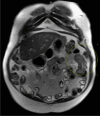Jejunal Lipoma-Induced Intussusception Mimicking Crohn's Disease: A Case Report
- PMID: 40271495
- PMCID: PMC12017744
- DOI: 10.1159/000545297
Jejunal Lipoma-Induced Intussusception Mimicking Crohn's Disease: A Case Report
Abstract
Introduction: Chronic gastrointestinal bleeding in patients with Crohn's disease presents diagnostic challenges. Adult intussusception is rare and typically caused by a pathological lead point, such as a tumor or inflammatory lesion. Lipomas, though benign, can lead to obstruction and bleeding, requiring differentiation from inflammatory causes for appropriate management.
Case presentation: A 70-year-old male with Crohn's disease and chronic anemia presented with recurrent obscure gastrointestinal bleeding. Initial endoscopy was unremarkable, but capsule endoscopy identified a bleeding jejunal lesion. Double-balloon enteroscopy and imaging confirmed a jejunal lipoma causing intermittent intussusception. Due to persistent anemia, the patient underwent laparoscopic resection, with pathology confirming an ulcerated lipoma. His anemia resolved postoperatively.
Conclusion: This case underscores the importance of considering structural lesions like lipomas in patients with chronic bleeding and Crohn's disease. A multimodal approach, including advanced imaging and enteroscopy, is crucial for accurate diagnosis and management. Surgical resection remains the preferred treatment for symptomatic small bowel lipomas.
Keywords: Crohn’s disease; Differential diagnosis; Intussusception; Small intestine.
© 2025 The Author(s). Published by S. Karger AG, Basel.
Conflict of interest statement
The authors have no conflicts of interest to declare.
Figures



Similar articles
-
Ulcerated intussuscepted jejunal lipoma-uncommon cause of obscure gastrointestinal bleeding: A case report.World J Clin Cases. 2019 Nov 26;7(22):3765-3771. doi: 10.12998/wjcc.v7.i22.3765. World J Clin Cases. 2019. PMID: 31799302 Free PMC article.
-
A unique case of massive gastrointestinal bleeding.SAGE Open Med Case Rep. 2017 Mar 17;5:2050313X17700345. doi: 10.1177/2050313X17700345. eCollection 2017. SAGE Open Med Case Rep. 2017. PMID: 28540052 Free PMC article.
-
Intermittent melena and refractory anemia due to jejunal cavernous lymphangioma: A case report.World J Gastrointest Surg. 2024 Apr 27;16(4):1208-1214. doi: 10.4240/wjgs.v16.i4.1208. World J Gastrointest Surg. 2024. PMID: 38690049 Free PMC article.
-
Balloon-Assisted Enteroscopy and Capsule Endoscopy in Suspected Small Bowel Crohn's Disease.Clin Endosc. 2017 Sep;50(5):417-423. doi: 10.5946/ce.2017.142. Epub 2017 Sep 29. Clin Endosc. 2017. PMID: 29017295 Free PMC article. Review.
-
Distinct management issues with Crohn's disease of the small intestine.Curr Opin Gastroenterol. 2015 Mar;31(2):92-7. doi: 10.1097/MOG.0000000000000149. Curr Opin Gastroenterol. 2015. PMID: 25594888 Review.
References
Publication types
LinkOut - more resources
Full Text Sources

